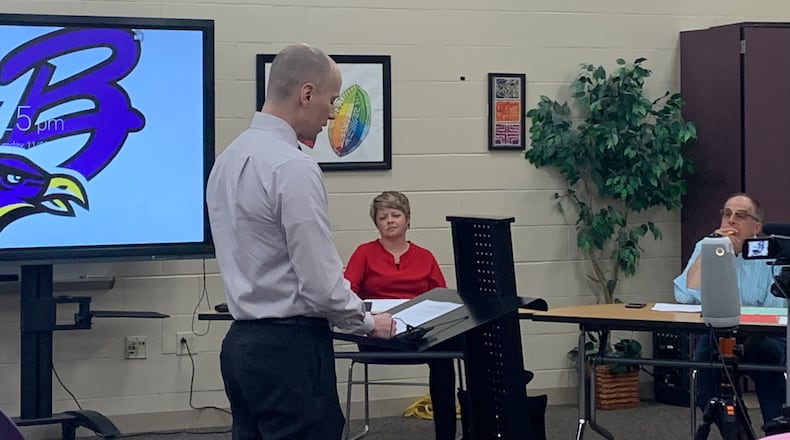Two weeks ago, as part of about 20 disparate revisions made to the school board’s policy, the board removed language from their anti-harassment policy regarding LGBT students and staff, sparking backlash from the community. While multiple protections against discriminatory harassment remained in the policy, including those based on race, color, national origin, sex, disability, age, religion, ancestry or genetic information, the notation “sexual orientation and gender identity,” was removed.
Board member Audra Dorn said she met with students from Bellbrook High School’s Gay Straight Alliance club in the days after that board meeting to discuss the policy language, adding that Thursday’s proposed addition was a collaboration between administration and students.
“Bullying for any reason is wrong, and if you disagree with that, then I disagree with you,” Dorn said.
Multiple board members emphasized Thursday that the changes two weeks ago did not remove bullying and harassment protections from LGBT students, as the zero-tolerance policy toward bullying applies to all students that attend Bellbrook schools.
However, the measure Thursday, re-adding the language to a sub-section of the policy, is meant to “provide some reassurance that this policy does apply” to LGBT students, Dorn said.
“I am happy to make sure that people understand that they are protected here,” she said.
Board member Heidi Anderson cast the single dissenting vote Thursday evening, saying the addendum as currently written did not fulfil the purpose of being “effective or inclusive.”
“I have concerns about any language that makes any group a target, or gives impressions that students’ bullying experiences any less important or valid than any specific group that is mentioned,” Anderson said.
Anderson said that the board’s time and resources would be better spent ensuring the board’s anti-bullying policies are being followed, saying there was a discrepancy between the number of reported bullying incidents and the stories from parents and students.
“In order to truly protect our LGBTQIA+ community, we need to do better than divisive words in a policy,” Anderson said. “We as a board need to send a strong message that we expect a zero tolerance policy to actually mean zero tolerance.”
Some students and members of the community who spoke at Thursday’s meeting said the changes are a step in the right direction.
“When people see something representing them in the rules, and in policy specifically, that makes them feel safer,” said Bellbrook student Ben Pursel. “ ‘All students’ is very clear. But I think that when you can directly relate to something on a deeper level, more than just a student, more who you are, I think that is providing something super positive to the students.”
However, other members of the community continued to question why the policy changes were necessary.
“I’d like to hear the answer...on how this came about,” said community member David Buccalo. “Did it come through your administrative offices? Did it come through your legal offices? The people who are writing your code? Or did it come through one of you?”
Board President Mike Kinsey re-emphasized Thursday that the policy changes two weeks ago were meant to better align with the “current legal landscape.”
“There are risks associated if policies fall outside of the law,” Kinsey said. “It may not be a very exciting answer, but that’s the ‘why.’ ”
Kinsey declined to comment further on Thursday, citing the breadth and depth of federal and state legislation that govern schools on this matter.
About the Author

